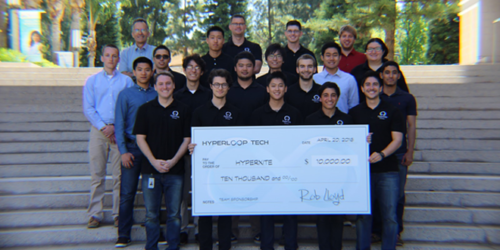
Editor’s Note: I’ve had the distinct pleasure of consulting for the UCI HyperXite team, and in appreciation they have provided this “guest post” for readers of The Automation Blog.
IRVINE, Ca. – May 24, 2016 – HyperXite, UCI’s very own competitive Hyperloop team, is working around the clock to complete their 1:2 scale pod that will be used in the final stage of the SpaceX Hyperloop Pod Competition this summer.
The Hyperloop is a concept first proposed by Elon Musk and SpaceX in 2013 and would connect major cities, typically hours apart, together with travel times as low as thirty-five minutes.
HyperXite is currently developing and building the next generation of transportation that is safer, cheaper, faster and more energy efficient than cars, planes, boats and trains.
A major focus of this project has been sustainable and renewable energy and the effects of travel on the environment. The Hyperloop aims to revolutionize the way we travel while simultaneously ensuring we leave behind a clean, integrated system for generations to come.
Solar panels along the top of the track will make the Hyperloop completely self-sustainable and will produce zero carbon emissions, making it one of the cleanest systems of transportation.
HyperXite has recently received a grant from The Green Initiative Fund at UCI for their work in promoting environmental sustainability and awareness on the UC Irvine campus. The project has changed the way Mackenzie Puig-Hall, a HyperXite team member, views the possibility of sustainable travel.
“Being involved in HyperXite has made me think about the future of renewable transportation as making sure the most environmentally responsible option is also the best option for individuals so that people will naturally gravitate towards renewable transportation.”
Currently, HyperXite is working on improving designs based on feedback from SpaceX advisors and engineers. They have recruited industry experts such as E3, Pacific Composites, and Huntington Mechanical Labs to assist with their machining needs such as such as providing mentorship and the use of CNC machines.
Extensive testing must be done on each component prior to actually building the pod. Components are vacuum tested at pressures hundreds of times lower than the competition tube to ensure functionality and safety, and each system is subject to rigorous bench testing before assembly on the pod.
Gabriel Buenviaje, a senior mechanical engineer and Braking Lead for HyperXite, has been involved in much of the testing and weighed in on what motivates him. “The fact is we are undergraduate college students working on a project that has potential to change the future of transportation.
The possibility of having HyperXite’s name and its members’ names in such an important project fuels my ambition.” When asked what advice he would give future students who are considering taking on a project of this scale, Patricio Guerrero, senior mechanical and aerospace engineer and Team Captain for HyperXite, simply said, “You have to be crazy.”
Article provided by the UCI HyperXite Team.





